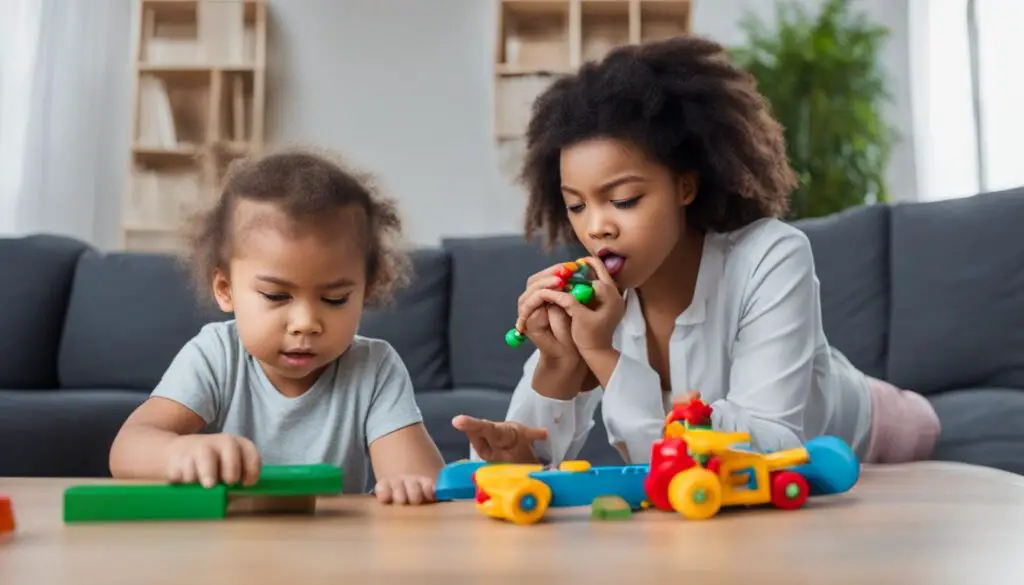
How to Effectively Manage Toddler Tantrums
Tantrums are a common occurrence during the toddler years and can be challenging for both parents and children. However, with the right strategies in place, it is possible to effectively manage and decrease the frequency of tantrums.
According to research from the Child Mind Institute, toddlers tend to have tantrums when they are hungry, tired, or overwhelmed. Setting clear limits, providing positive reinforcement, and teaching emotional regulation skills are effective tactics for managing tantrums in toddlers, as suggested by studies published in the Journal of Positive Behavior Interventions.
Key Takeaways:
- Understanding the triggers that can lead to tantrums is essential in managing and preventing them.
- Establishing consistent routines creates a predictable and structured environment that helps reduce tantrums.
- Positive reinforcement encourages positive behavior and can reduce the likelihood of tantrums.
- Distraction techniques, such as redirecting a child’s attention, can diffuse tantrums and prevent escalation.
- Managing toddler tantrums requires patience, consistency, and seeking support from professionals if necessary.
Understanding the Triggers
It is important for parents to understand the triggers that can lead to tantrums in toddlers. Identifying these triggers is crucial for effectively managing and preventing tantrums.
Common Triggers
Tantrum triggers can vary from child to child, but there are some common triggers that parents should be aware of:
- Hunger
- Fatigue
- Frustration
- Desire for independence
According to the American Academy of Pediatrics, these triggers can often contribute to tantrum outbursts in toddlers. By recognizing when these triggers are present, parents can take proactive measures to prevent or address tantrums before they escalate.
Difficult Temperament Traits
A study published in the Journal of Child Psychology and Psychiatry suggests that children who display difficult temperament traits are more likely to experience tantrums. These traits include:
- Low adaptability
- Intense emotions
Children with these temperament traits may be more prone to frustration and difficulty regulating their emotions, making them more susceptible to tantrums.
Identifying Triggers
Recognizing tantrum triggers is key to effectively managing tantrums in toddlers. By observing your child’s behavior and noting patterns, you can identify their specific triggers. This can involve keeping a journal or taking mental notes when tantrums occur. The more you understand your child’s triggers, the better equipped you will be to prevent or defuse tantrum situations.
In the next section, we will explore how establishing consistent routines can help minimize tantrum occurrences.
Establishing Consistent Routines
Research conducted by the University of Michigan has shown that consistent routines play a crucial role in reducing tantrums in toddlers. By providing a predictable and structured environment, we can create a sense of security and help children feel more in control of their emotions. This, in turn, minimizes the likelihood of tantrums.
One of the key aspects of establishing consistent routines is having regular meal times, nap times, and bedtimes. These routines provide a framework for the day and help children anticipate what comes next. They create a predictable environment that instills a sense of stability and reassurance.
Another crucial element of consistent routines is setting and maintaining consistent rules and expectations. When children know what is expected of them, they feel more secure and are less likely to engage in behaviors that lead to tantrums. It is important to communicate these rules clearly and consistently enforce them.
“Consistent routines provide a foundation for a predictable environment, which is essential for preventing tantrums in toddlers.” – University of Michigan Research
In addition to meal times, nap times, bedtimes, rules, and expectations, utilizing visual cues can be highly beneficial for toddlers. Charts or schedules that outline their daily routines can help them understand what is expected of them and reduce frustration. Visual cues provide a tangible representation of the routines, making them more easily understandable for young children.
By establishing consistent routines, we create a stable and predictable environment that minimizes the likelihood of tantrums. These routines instill a sense of security, empower children to feel more in control, and provide them with clear expectations. Remember, consistency is key in effectively managing and preventing tantrums.

| Benefits of Establishing Consistent Routines | Examples |
|---|---|
| Reduces tantrums | Regular meal times, nap times, and bedtimes |
| Creates a predictable environment | Maintaining consistent rules and expectations |
| Increases a sense of security | Utilizing visual cues such as charts or schedules |
Positive Reinforcement and Distraction Techniques
When it comes to managing toddler tantrums, positive reinforcement and distraction techniques can be highly effective strategies. Research published in the Journal of Applied Behavior Analysis highlights the power of positive reinforcement in encouraging positive behavior and reducing the likelihood of tantrums. By providing praise and rewards for desirable actions, parents can create a positive environment that motivates their toddlers to engage in more constructive behaviors.
Additionally, distraction techniques can play a crucial role in diffusing tantrums and redirecting a child’s attention. A study in the Journal of Abnormal Child Psychology found that introducing a different activity or object can help calm toddlers down and prevent tantrums from escalating. By shifting their focus and engaging them in something new, distractions can help children regulate their emotions and avoid outbursts.
Positive reinforcement and distraction techniques are valuable tools for managing toddler tantrums. By using praise, rewards, and redirection, parents can encourage positive behavior and diffuse tantrums effectively.
Parents can implement positive reinforcement by verbally praising their child’s good behavior, such as saying, “You did a great job sharing your toys!” or “I’m proud of how you managed your frustration.” Rewards can also be used, such as stickers, small treats, or additional playtime, to reinforce positive actions and motivate toddlers to continue behaving well.
When it comes to distraction techniques, parents can have a few strategies up their sleeves. They can introduce a new toy or game to capture their child’s attention, redirect them to a different activity or area, or initiate a change in scenery. By creatively distracting their toddlers, parents can help them shift their focus away from the triggering event and regain control of their emotions.
Ultimately, implementing positive reinforcement and distraction techniques requires consistency and patience. It’s important for parents to observe their child’s behavior and tailor these strategies to their individual needs. By combining these effective tactics, parents can navigate tantrum situations with confidence and create a more harmonious environment for their family.

Comparison of Positive Reinforcement and Distraction Techniques
| Positive Reinforcement | Distraction Techniques |
|---|---|
| Encourages positive behavior | Redirects attention |
| Provides praise and rewards | Introduces new activities or toys |
| Motivates toddlers to engage in desirable actions | Shifts focus away from triggering event |
| Reduces likelihood of tantrums | Helps regulate emotions |
| Creates a positive and encouraging environment | Calms toddlers and prevents escalations |
Conclusion
Managing toddler tantrums can be challenging, but with the right strategies and techniques, parents can effectively reduce tantrum frequency and create a more peaceful home environment. By understanding the triggers that lead to tantrums, such as hunger, fatigue, and frustration, parents can proactively address these issues and prevent tantrums from occurring. Establishing consistent routines and providing clear rules and expectations helps toddlers feel secure and in control, reducing their likelihood of having tantrums.
Positive reinforcement is a valuable tool in managing tantrums. By praising and rewarding positive behavior, parents can encourage their toddlers to engage in desirable actions and reduce the occurrence of tantrums. Distraction techniques, such as redirecting the child’s attention to a different activity or object, can also be effective in diffusing tantrums and preventing them from escalating.
It’s important to remember that every child is unique, so finding the most effective strategies may require some trial and error. Patience and consistency are key in managing toddler tantrums. If needed, don’t hesitate to seek support from professionals who specialize in child behavior. With time and persistence, parents can overcome this stage and restore harmony in their homes, creating a peaceful environment for both themselves and their toddlers.
FAQ
How can I effectively manage my toddler’s tantrums?
Tantrums can be challenging, but there are strategies that can help. Understanding the triggers, establishing consistent routines, using positive reinforcement, and implementing distraction techniques are effective in managing tantrums.
What are some common triggers for toddler tantrums?
Hunger, fatigue, frustration, and a desire for independence are common triggers for tantrums in toddlers.
How can I identify the triggers that lead to my toddler’s tantrums?
It is important to observe your child’s behavior and look for patterns. Notice if your child is hungry, tired, or experiencing any frustrations before a tantrum occurs. This will help you identify the triggers and manage tantrums more effectively.
How can establishing consistent routines help prevent tantrums?
Consistent routines provide a sense of security and help children feel more in control. Regular meal times, nap times, bedtime, and consistent rules and expectations create a predictable environment that reduces frustration and tantrums.
How does positive reinforcement and distraction techniques help in managing tantrums?
Praising and rewarding positive behavior encourages toddlers to engage in more desirable actions and reduces the likelihood of tantrums. Distraction techniques, such as redirecting the child’s attention to a different activity or object, can help calm them down and prevent tantrums from escalating.